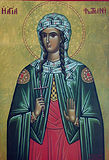

| Previous day | Next day |
| Old Style
March 20
|
Saturday |
New Style
April 2
|
|
4th Week of Great Lent. Fourth Saturday of Great Lent. Commemoration of the Dead.
Tone 7.
Great Lent. |
Wine and oil allowed.
|
![]() The Holy Fathers who were slain at the Monastery of St. Sabbas: Sts. John, Sergius, Patrick, and others (796).
The Holy Fathers who were slain at the Monastery of St. Sabbas: Sts. John, Sergius, Patrick, and others (796).
Martyrs Photina (Svetlana), the Samaritan woman; her sisters Phota, Photis, Parasceva, and Cyriaca; her sons Victor (or Photinus) and Joses; and Sebastian the Duke, the officer Anatolius, and Theoclitus, the former sorcerer—all martyred under Nero (ca. 66). Seven Virginmartyrs of Amisus (Samsun): Alexandra, Claudia, Euphrasia, Matrona, Juliana, Euphemia, and Theodosia (310). St. Nicetas the Confessor, bishop of Apollonias in Bithynia (9th c.). Suffering of St. Euphrosynus of Blue-Jay Lake (Novgorod) (1612).
Righteous Abel, first martyr in the history of mankind. St. Martin of Braga in Iberia (580). St. Cuthbert of Lindisfarne, bishop (687). St. Herbert of Derwentwater, priest and hermit (687). Hieromartyr Tadros, bishop of Edessa, at Jerusalem (691). Martyr Michael the Sabbaite, at Jerusalem (691). St. Wulfram, missionary (Neth.) (703). Martyr Archil II, king of Georgia (744). New Martyr Myron of Mega Castro on Crete (1793). New Hieromartyr Nicholas Holz, priest, of Novosiolki (Chelm and Podlasie, Poland) (1944).
Thoughts for Each Day of the Year
According to the Daily Church Readings from the Word of God
By St. Theophan the Recluse

Saturday. [Heb. 6:9–12; Mark 7:31–37]
Flesh and blood cannot inherit the Kingdom of God (I Cor. 15:50). Consequently, to receive the kingdom it is necessary to become fleshless and bloodless—that is, to become steadfast in such a nature of life wherein blood and flesh literally do not exist. This is attained by a complete renunciation of deeds that come from flesh and blood. Now the works of the flesh are manifest, which are these; Adultery, fornication, uncleanness, lasciviousness, idolatry, witchcraft, hatred, variance, emulations, wrath, strife, seditions, heresies, envyings, murders, drunkenness, revellings, and such like. Having listed all of these, the Apostle adds: I tell you before, as I have also told you in time past, that they which do such things shall not inherit the Kingdom of God (Gal. 5:19–21). He that has ears to hear, let him hear (cf. Matt. 11:15)!
Articles
 Martyred Holy Fathers who were slain at the Monastery of St SabbasSaints John, Sergius, Patrick and others were slain in the Monastery of Saint Sabbas. |
 Martyr Kyriake of RomeSaint Kyriake was the sister of the Holy Martyr Photina (Svetlana) the Samaritan Woman, with whom the Savior conversed at Jacob’s Well (John. 4:5-42). |
 Martyr Archil II the King of GeorgiaThe Holy Martyr Archil II, King of Georgia belonged to the dynasty of the Chosroidoi, and he was a direct descendant of the holy emperor St Mirian (+ 342). |








